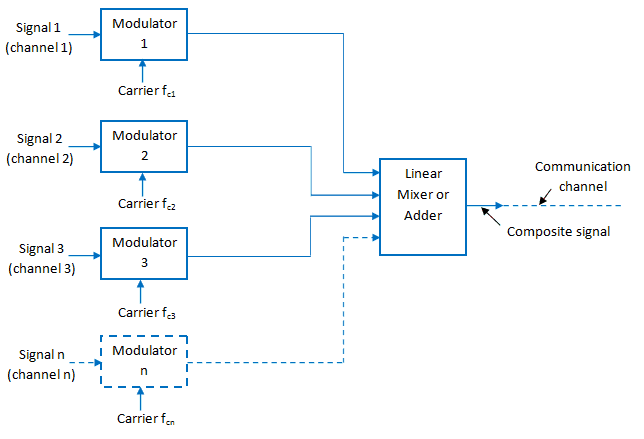Frequency-Division Multiplexing (FDM) is a specialized form of multiplexing that allows multiple signals to coexist in a single communication channel. By allocating different frequency bands to different data streams, FDM ensures efficient utilization of available bandwidth. This article aims to explore the concept of FDM, its historical context, how it works, its applications in modern networking, and its relation to other types of multiplexing.
In this article:
- What is FDM?
- Historical Context of Frequency-Division Multiplexing
- How FDM Works
- Applications of FDM in Modern Networking
- Comparison with Other Multiplexing Techniques
- Future Prospects and Limitations
- Video
- References
1. What is FDM?
Frequency-division multiplexing (FDM) is a signal transmission technology in which multiple signals can simultaneously be transmitted over the same line or channel. Frequency-division multiplexing (FDM) can be used in both wired and wireless networking for transmitting large amounts of data at high speeds. FDM is the simplest and oldest form of multiplexing in wireless networking technology.
The channel’s available bandwidth is divided into separate frequency bands, each allocated to a different signal.

Differentiation from General Multiplexing
While multiplexing as a concept involves combining multiple signals for transmission over a shared medium, FDM is a specific subtype that uses varying frequency bands to accomplish this. This sets it apart from other multiplexing methods like Time-Division Multiplexing (TDM) or Wavelength-Division Multiplexing (WDM).
2. Historical Context of Frequency-Division Multiplexing
Early Uses in Telecommunications
Initially, FDM found its roots in telecommunications to facilitate long-distance calls over a single wire. It allowed operators to increase the number of calls that could be placed simultaneously, revolutionizing the industry.
Evolution in Computer Networking
With the advent of computer networks, FDM became an attractive option for data transmission, especially in systems that used coaxial or fiber-optic cables. It became instrumental in both local and wide-area networking solutions.
3. How FDM Works?
Frequency Allocation and Bandwidth
In FDM, each data stream or channel is allocated a specific frequency range within the broader channel bandwidth. These individual frequency ranges, known as sub-bands, are carefully chosen to not overlap with one another. This non-overlapping allocation is essential in preventing signal interference, thereby ensuring that each signal remains distinct throughout the transmission process.
Guard Bands
To further minimize the risk of interference, FDM often uses “guard bands.” These are unused portions of the frequency spectrum placed between sub-bands to act as buffers. They provide an additional layer of assurance against ‘bleeding over’ from one channel to another.
Signal Modulation and Demodulation
Before transmission, each data stream is modulated onto its designated carrier frequency. Various modulation techniques, such as amplitude modulation (AM) or frequency modulation (FM), may be used depending on the specific application and requirements.
Modulation Techniques in FDM
- Amplitude Modulation (AM)
- Frequency Modulation (FM)
- Phase Modulation (PM)
At the receiving end, demodulation techniques are applied to extract the original signals from their carrier frequencies. The process of demodulation essentially reverses the modulation, turning the received signals back into a form that can be understood by the receiving system.
4. Applications of FDM in Modern Networking
Use in Analog and Digital Systems
While FDM was initially more prevalent in analog systems, it still finds use in various digital communication setups. It is often considered a stepping stone to more complex multiplexing methods and serves as an educational tool for understanding the basics of signal transmission.
FDM in Digital Subscriber Lines (DSL)
In the realm of internet connectivity, DSL is an example of a digital system where FDM is utilized. In DSL, one frequency band is used for downstream data, another for upstream data, and often a third for plain old telephone service (POTS).
Real-world Examples
» Radio and Television Broadcasting
FDM plays a critical role in radio and TV broadcasting, where different stations operate on different frequency bands to avoid interference.
» Wireless Communication Systems
In wireless systems like Wi-Fi and cellular networks, FDM is used to allow multiple users to access the network simultaneously. Here, each user is assigned a unique frequency band to minimize the risk of cross-talk or interference.
» Maritime and Aviation Communication
FDM is vital in safety-critical communications such as those used in maritime and aviation industries. Therefore, distinct frequency bands are allocated for different types of messages to ensure that important signals are not lost or interfered with.
Advanced Applications: Orthogonal FDM (OFDM)
Orthogonal FDM (OFDM) is a more advanced form of FDM used in modern high-speed data transmission systems like 4G and 5G cellular networks, as well as in Wi-Fi standards like 802.11ac and 802.11ax. OFDM improves upon traditional FDM by making more efficient use of the available bandwidth.
5. Comparison with Other Multiplexing Techniques
Time-Division Multiplexing (TDM)
TDM uses time slots rather than frequency bands to separate signals. It’s often used in digital systems and has some advantages over FDM in certain scenarios.
Wavelength-Division Multiplexing (WDM)
WDM is similar to FDM but is specifically used in optical fiber networks. It multiplexes signals based on different wavelengths of light.
6. Future Prospects and Limitations
Technological Advances
As technology advances, newer multiplexing techniques are emerging, many of which are rooted in the principles of FDM.
Challenges and Limitations
Furthermore, while FDM has its merits, it’s not without challenges such as signal bleed-over and the requirement for precise frequency tuning.
7. Video
References
- “Computer Networking: A Top-Down Approach” by James Kurose & Keith Ross
- RFC 768 – User Datagram Protocol (UDP)
- RFC 791 – Internet Protocol (IP)
- Cisco Networking Academy
- Network Engineering Stack Exchange